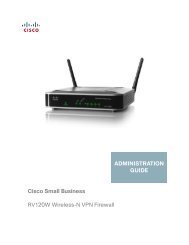Cisco Catalyst 6500 Supervisor 2T Architecture - Ipland
Cisco Catalyst 6500 Supervisor 2T Architecture - Ipland
Cisco Catalyst 6500 Supervisor 2T Architecture - Ipland
Create successful ePaper yourself
Turn your PDF publications into a flip-book with our unique Google optimized e-Paper software.
White Paper● 802.1Q VLAN encapsulation● ECC protectionBridge ASICThe bridge ASIC primarily serves as the gateway for linecards using the bus to connect to the control plane and dataplane (MSFC5 and PFC4 respectively). It provides a connection into the bus backplane and receives packets fromlinecards, which it will forward to the MSFC5 or PFC4 for processing. It provides a packet buffer, as well as flowcontrol to manage data flows from the linecards. Once packet processing is complete for the packet, the bridge ASICwill send the results of the forwarding operation back over the bus to the classic linecards.MSFC5/PFC4Both of these will be discussed individually in more detail later in this paper.MSFC5The MSFC5 is a next-generation CPU daughter card for the <strong>Supervisor</strong> <strong>2T</strong>. It is not an optional daughter card andwill be present on every <strong>Supervisor</strong> <strong>2T</strong>. The MSFC5 cannot be installed on any other <strong>Supervisor</strong> 32 or <strong>Supervisor</strong>720, and is designed for the exclusive use on the <strong>Supervisor</strong> <strong>2T</strong>.The MSFC5 performs control plane services for the switch. Control plane functions typically process all thosefeatures and other processes that are not handled directly in hardware by purpose built ASICs. The MSFC5 CPUhandles Layer 2 and Layer 3 control plane processes, such as the routing protocols, management protocols likeSNMP and SYSLOG, and Layer 2 protocols (such as Spanning Tree, <strong>Cisco</strong> Discovery Protocol, and others), theswitch console, and more.Figure 5.MSFC5 on <strong>Supervisor</strong> <strong>2T</strong>On previous generations of the MSFC, there were two main CPU complexes that resided on the MSFC. These CPUcomplexes were known as the Route Processor (RP) and Switch Processor (SP) complex. The RP complex wasresponsible for performing Layer 3 control plane services, IOS configuration and associated management of theconfiguration, Address Resolution Protocol (ARP) processing, Internet Control Message Protocol (ICMP) processingand more.© 2011-2012 <strong>Cisco</strong> and/or its affiliates. All rights reserved. This document is <strong>Cisco</strong> Partner Confidential Information. Page 13 of 46
















